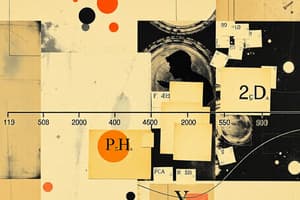Podcast
Questions and Answers
Match the following definitions with the correct terms:
Match the following definitions with the correct terms:
Strong Acid = Good proton donor Weak Acid = Poor proton donor Strong Base = Good proton acceptor Weak Base = Poor proton acceptor
Match the following acids with their strength classification:
Match the following acids with their strength classification:
HCl = Strong Acid H2SO4 = Strong Acid Ethanoic Acid = Weak Acid NH3 = Weak Base
Match the following chemical symbols with their meanings:
Match the following chemical symbols with their meanings:
K_a = Acid dissociation constant K_b = Base dissociation constant [H^+] = Hydrogen ion concentration [OH^-] = Hydroxide ion concentration
Match the following pH measurement tools with their descriptions:
Match the following pH measurement tools with their descriptions:
Match the following acid-base reactions with their classifications:
Match the following acid-base reactions with their classifications:
Match the following indicators with their respective pH range:
Match the following indicators with their respective pH range:
Match the following indicators with their acid and base colors:
Match the following indicators with their acid and base colors:
Match the following terms with their definitions:
Match the following terms with their definitions:
Match the following values with their meanings:
Match the following values with their meanings:
Match the following components involved in a pH titration:
Match the following components involved in a pH titration:
Match the following pH values with their corresponding solution types:
Match the following pH values with their corresponding solution types:
Match the following actions in a titration with their outcomes:
Match the following actions in a titration with their outcomes:
Match the following terms with their definitions or actions:
Match the following terms with their definitions or actions:
Match the following formulas with their descriptions:
Match the following formulas with their descriptions:
Match the following statements with their truths:
Match the following statements with their truths:
Match the following titration types with their characteristics:
Match the following titration types with their characteristics:
Match the acid-base theories with their definitions:
Match the acid-base theories with their definitions:
Match the indicators with their suitable titration:
Match the indicators with their suitable titration:
Match the pH calculations with their corresponding solutions:
Match the pH calculations with their corresponding solutions:
Match the concepts of strong and weak acids:
Match the concepts of strong and weak acids:
Match the experimental setup to the acid-base reaction:
Match the experimental setup to the acid-base reaction:
Match the function of hydroxyl ions with its effect in reactions:
Match the function of hydroxyl ions with its effect in reactions:
Match the chemical formulas with their corresponding substances:
Match the chemical formulas with their corresponding substances:
Match the following pH calculations with their solutions:
Match the following pH calculations with their solutions:
Match the following indicators with their behavior in acid or base:
Match the following indicators with their behavior in acid or base:
Match the following acids/bases with their dissociation constants:
Match the following acids/bases with their dissociation constants:
Match the following pH scale limitations:
Match the following pH scale limitations:
Match the following formulas for calculating pH:
Match the following formulas for calculating pH:
Match the following reactions with their respective components:
Match the following reactions with their respective components:
Match the following pH outcomes with their respective substances:
Match the following pH outcomes with their respective substances:
Match the following acids and their characteristics:
Match the following acids and their characteristics:
Flashcards
Self-ionization of water
Self-ionization of water
The process where water molecules react with each other to produce hydrogen and hydroxide ions.
Ionic product of water (Kw)
Ionic product of water (Kw)
The equilibrium constant for the self-ionization of water, at a specific temperature.
pH
pH
A measure of the hydrogen ion concentration in a solution, expressed as the negative logarithm (base 10) of the hydrogen ion concentration.
pH of a neutral solution
pH of a neutral solution
Signup and view all the flashcards
pH scale
pH scale
Signup and view all the flashcards
pH of a solution
pH of a solution
Signup and view all the flashcards
Strong acid
Strong acid
Signup and view all the flashcards
Weak acid
Weak acid
Signup and view all the flashcards
Conjugate acid-base pair
Conjugate acid-base pair
Signup and view all the flashcards
Acid dissociation constant (Ka)
Acid dissociation constant (Ka)
Signup and view all the flashcards
pH of strong acid (H₂SO₄)
pH of strong acid (H₂SO₄)
Signup and view all the flashcards
pH of strong base (NaOH)
pH of strong base (NaOH)
Signup and view all the flashcards
pH scale limitations
pH scale limitations
Signup and view all the flashcards
Calculating weak acid pH
Calculating weak acid pH
Signup and view all the flashcards
Weak acid calculation method
Weak acid calculation method
Signup and view all the flashcards
Acid-base indicator
Acid-base indicator
Signup and view all the flashcards
Le Chatelier's Principle in indicators
Le Chatelier's Principle in indicators
Signup and view all the flashcards
Dissociation constant (Ka)
Dissociation constant (Ka)
Signup and view all the flashcards
pH Titration Curve
pH Titration Curve
Signup and view all the flashcards
Equivalence Point
Equivalence Point
Signup and view all the flashcards
Indicator
Indicator
Signup and view all the flashcards
Strong Acid/Strong Base Titration
Strong Acid/Strong Base Titration
Signup and view all the flashcards
Weak Acid/Strong Base Titration
Weak Acid/Strong Base Titration
Signup and view all the flashcards
Weak Acid/Weak Base Titration
Weak Acid/Weak Base Titration
Signup and view all the flashcards
Conjugate Pair
Conjugate Pair
Signup and view all the flashcards
Brønsted-Lowry Theory
Brønsted-Lowry Theory
Signup and view all the flashcards
Indicator as a weak base
Indicator as a weak base
Signup and view all the flashcards
Indicator's pH Range
Indicator's pH Range
Signup and view all the flashcards
pH Titration
pH Titration
Signup and view all the flashcards
pH Titration Setup
pH Titration Setup
Signup and view all the flashcards
Study Notes
Self-Ionisation of Water
- Water conducts electricity when ions are present
- Pure water conducts a small current due to self-ionisation
- H₂O ⇌ H⁺ + OH⁻
- Equilibrium favors the left side, concentrations of H⁺ and OH⁻ are very small
- The concentration of H₂O is considered constant
- Equilibrium constant (K) = [H⁺][OH⁻]/[H₂O]
- Kw = lonic product of water, Kw = 1 x 10⁻¹⁴ at 25°C
- [H⁺] = 1 x 10⁻⁷ mol/L, [OH⁻] = 1 x 10⁻⁷ mol/L for pure water
pH Scale
- pH = -log₁₀[H⁺]
- Concentration is in moles per litre
- pH of a solution measures the concentration of hydrogen ions
- Value ranges from 0-14
- pH less than 7 = acidic
- pH greater than 7 = alkaline
- pH 7 = neutral
Strengths of Acids and Bases
-
Strong acid: Good proton donor. Example: HCl, H₂SO₄. Completely dissociates in water.
-
Weak acid: Poor proton donor. Example: Ethanoic acid. Slightly dissociates in water.
-
Strong base: Good proton acceptor. Example: NaOH, KOH. Completely dissociates in water.
-
Weak base: Poor proton acceptor, Example: NH₃. Slightly dissociates in water.
-
Ka: Acid dissociation constant
-
Kb: Base dissociation constant
Calculating pH of Strong Acids and Bases
- Strong acids and bases fully dissociate in water, so assume complete dissociation when calculating pH
- Example: 0.4 M H₂SO₄ solution produces 0.8 moles of H⁺ ions, pH of ~0.1
- pH of a strong base: pOH = -log₁₀[OH⁻] then pH=14-pOH
Limitations of the pH Scale
- The pH scale is limited to the range 0.1 - 14, theoretically possible outside
- Applicable to dilute aqueous solutions at 25°C
- Does not work at extremely low concentrations
Calculating pH of Weak Acids and Bases
- To find pH of a weak acid or base, need the dissociation constant
- Example: Calculating pH of 0.1 M ethanoic acid using Ka = 1.8 x 10⁻⁵, results in a pH of ~2.9
Acid-Base Indicators
- A substance that changes color based on the solution's pH
- Indicators are weak acids or bases; color change occurs with pH changes
- The indicator shows a clear range of color change, useful for titration
- Examples include: Methyl Orange and Phenolphthalein
pH Titration
- Experiment measuring pH change during acid-base reaction
- Acid in beaker, base in burette, pH measured as base added
- Curve of pH versus volume plotted; The equivalence point on the curve helps determine the endpoint
- Titrating strong acid vs strong base - large change in pH near endpoint
- Titrating weak acid vs strong base - large change in pH near endpoint
- Titrating weak acid vs weak base - small change in pH near endpoint. No clear endpoint
Studying That Suits You
Use AI to generate personalized quizzes and flashcards to suit your learning preferences.




